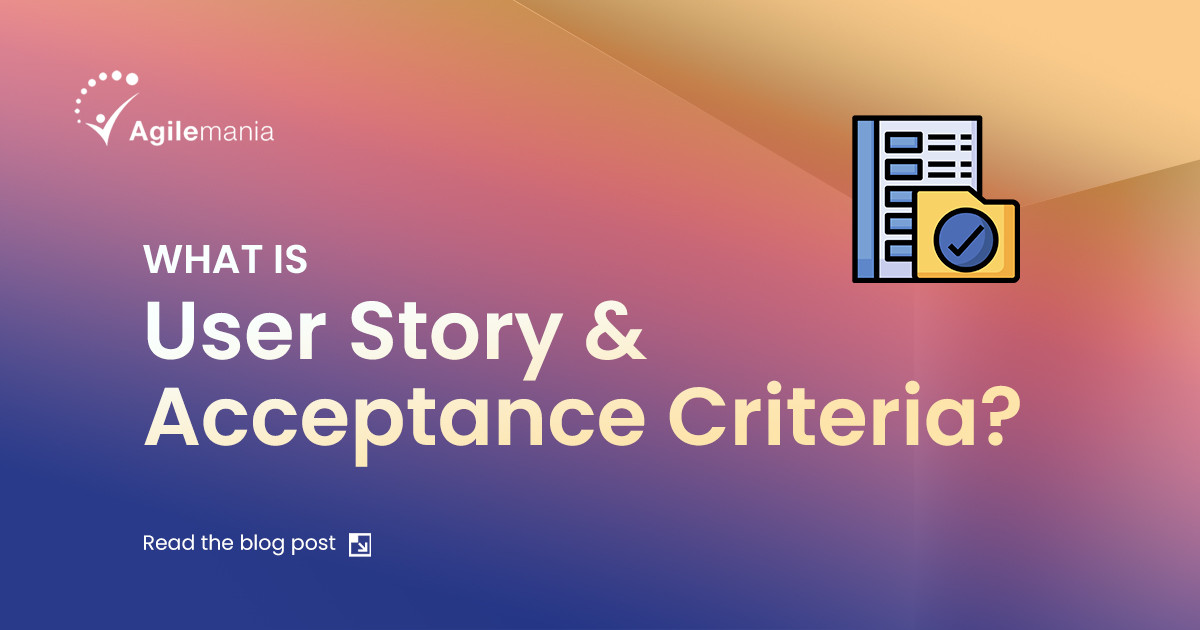
Agilemania
Agilemania, a small group of passionate Lean-Agile-DevOps consultants and trainers, is the most tru... Read more
![]() Get Your AI-Enabled Scrum Master Certification for Just ₹1,500 (Save 85%)!
Get Your AI-Enabled Scrum Master Certification for Just ₹1,500 (Save 85%)!
Scrum.Org
SAFe®
ICAgile
Scrum Alliance
Technical Agility
Kanban
Business Analysis
Project Management
AI-Enabled
Agilemania Academy
Scrum.Org
SAFe®
ICAgile
Scrum Alliance
Technical Agility
Kanban
Business Analysis
Project Management
AI-Enabled

Agilemania
Agilemania, a small group of passionate Lean-Agile-DevOps consultants and trainers, is the most tru... Read more

Have you ever thought about how software development teams make the features you need real? The answer is in two words: Acceptance criteria and User stories. These two words may sound a little technical, but they are the ideas that help you turn your requirements and ideas into something that can be done.
You will learn everything you need to know about these two important components of making software in this blog post. We will talk about what they are, why they are important, and how they work together to make a final product that satisfies your needs.
This blog post is for you if you are a new developer, product manager, or product owner. Save this page as a bookmark for later.
| Difference |
User Story
|
Acceptance Criteria
|
|---|---|---|
| (1) Focus |
Describes the user's needs and goals
|
Defines the specific conditions that must be met for the user story to be considered complete.
|
| (2) Perspective |
Written from the user's point of view.
|
Objective and measurable.
|
| (3) Content |
Briefly describes the desired functionality and the problem it solves for the user.
|
Lists detailed requirements and functionalities that need to be implemented.
|
| (4) Structure |
Typically follows the format: "As a <user type>, I want to <action> so that <benefit>."
|
Usually a bulleted list of specific and testable statements.
|
| (5) Example |
"As a customer, I want to be able to track my order history so that I can easily see the status of my past purchases."
|
The user can access their order history by logging into their account.
The order history displays the date, order number, items purchased, and current status of each order.
The user can filter their order history by date range or status.
|
User stories and acceptance criteria are needed for clear communication and successful outcomes in software development lifecycle. User stories help explain the "why" and "what" of a feature, while the acceptance criteria clearly explain the "how". Together, user stories and acceptance criteria can greatly reduce ambiguity throughout a project, allowing team members to code effectively and ultimately produce products that satisfy user needs.
Additionally, user stories and acceptance criteria are expressed concisely and measurably. Simple wording avoids using technical jargon that makes communication more complicated and helps develop a better understanding shared across the team.
Measurable acceptance criteria introduce clear ways to test by measuring the implementation of user requirements and success as 'done'. Finally, user stories and acceptance criteria are fluid, not static. As project development continues and evolves, user stories and acceptance criteria can always be revisited and edited to reflect ongoing changing needs of the project to deliver constant value to its end user.

Here are the main ways Acceptance Criteria can be used and help teams stay aligned, deliver quality, and achieve clear results:
Clarity and Alignment: Acceptance criteria make sure that all participants have a shared grasp of what the final product should be and how it should perform. This ensures there is not confusion and therefore allows for minimized miscommunication in future programming.
Measurable Success: By establishing specific and concrete barometers, the amount of development required to fulfill that task or feature is made meaningful. This barometer establishes efficient testing and keeps the project moving along correctly.
Communication and Collaboration: Acceptance criteria serve as a communal bridge across constituencies: developers, product owners, and testers. The framework will clear any impediments in communication and collaboration during the developing lifecycle.
Here are a few examples of User Stories with Acceptance Criteria:
User Story: As a registered user, I want to be able to log in to the website using my email address and password so that I can access my account and manage my purchases.
Acceptance Criteria:
The website should contain a login form located on the homepage and applicable pages.
User should be able to enter their email address (registered email) and password.
User should be taken to their account page when they successfully log in.
If the user enters an invalid login (wrong email address or password) they should receive a clear error message or instruction.
User sessions should timeout after a period of inactivity for security purposes.
User Story: As a user, I want to search products by name or category so that I can easily find the items I'm interested in purchasing.
Acceptance Criteria:
A search field needs to be on the main screen and readily visible or accessible.
Users can type keywords or product names in the search field.
Search results should display in a clear, organized manner and show useful information about the products (ex., name, image, price).
The search function will suggest or auto-complete as the user types in search queries.
People will be able to sort search results by price, category, brand, and other factors.
Projects can benefit from better communication, faster development, and a better likelihood of achieving user expectations if they set clear and specific acceptance criteria.
Build Better Products Faster: Enroll Now!
PSM I Certification
While user stories are meant to be brief, some functionalities might be inherently intricate. In such cases, it's okay to have a slightly longer user story, but ensure clarity and avoid excessive detail. Break down complex functionalities into smaller, more manageable user stories if possible.
Effective acceptance criteria are specific, measurable, achievable, relevant, and time-bound (SMART). They should be clear, testable, and cover various scenarios for the user story. Ask yourself: can these criteria objectively determine if the user story is truly "done"?
While the product owner usually outlines the user story, the entire development team (including developers, testers, and the product owner) collaboratively defines the acceptance criteria. This ensures everyone is on the same page about what "done" looks like.
Yes, acceptance criteria can evolve throughout the development process. As the team gains a deeper understanding of the user story and its implementation, the criteria might need adjustments to better reflect the desired outcome. However, ensure any changes are documented and communicated clearly to all stakeholders.
There's a fine line between providing enough detail and overcomplicating the criteria. Aim to be clear and concise while capturing the essential functionalities and expected user experience. Avoid micromanaging the implementation details; let the development team have the flexibility to find the best solution within the defined criteria.
Agilemania, a small group of passionate Lean-Agile-DevOps consultants and trainers, is the most trusted brand for digital transformations in South and South-East Asia.
WhatsApp Us

We will get back to you soon!
For a detailed enquiry, please write to us at connect@agilemania.com

